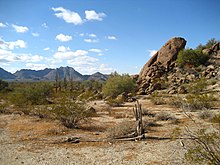California gopher tortoise
| California gopher tortoise | ||||||||||||
|---|---|---|---|---|---|---|---|---|---|---|---|---|

California gopher tortoise |
||||||||||||
| Systematics | ||||||||||||
|
||||||||||||
| Scientific name | ||||||||||||
| Gopherus agassizii | ||||||||||||
| ( Cooper , 1863) |
The California gopher tortoise ( Gopherus agassizii ) is a species of the tortoise family that belongs to the genus of the gopher tortoise . The species is native to the Mojave Desert and the Sonoran Desert in the southwestern United States of America and northern Mexico. It bears the scientific species name agassizii in memory of the scientist Louis Agassiz . The strictly protected animals do not play a role in terrarium keeping.
Appearance
The California gopher tortoise reaches a carapace of 25 to 36 centimeters. The males tend to be slightly larger than the females. In males, the belly armor is also concave. The back armor is highly arched and gray-green to dark brown in color. Adult California tortoises can weigh up to seven kilograms. The forelegs are scaly and flattened, which makes it easier for them to dig in the ground.
habitat
Like all species of gopher tortoise, this species of tortoise also lives in dry forests and on the edge of deserts. The ground temperatures can reach up to 60 degrees here. The gopher tortoise has adapted to these habitat conditions by digging very long and deep burrows and spending up to 95 percent of their time in them to avoid the heat. The deep caves also serve as protection for the turtles from freezing temperatures, which are reached in their habitat during the winter months. From November to February or March, this species of tortoise falls into winter rigor . The constructions of the California gopher tortoise are reused by other living things. These include other reptiles , mammals , birds and invertebrates .
Scientists now distinguish at least two, possibly three forms of California gopher tortoises, each of which use slightly different habitats, separating the population of the Mojave Desert and the Sonoran Desert and, as a possible third type, a population in the Black Mountains in northwest Arizona lives. The habitats differ in sandy areas or foothills . The population in the Mojave Desert, for example, lives mainly in alluvial cones and canyons , where they find sandy layers of earth that make it easier for them to build their caves.
The California gopher tortoise lives in regions that range from sea level to 1200 meters above sea level. It is assumed that these turtles are located within a radius of no more than four kilometers from their birth nesting pit. The turtle species can live to be 80 to 100 years old.
food
The California gopher tortoise is predominantly herbivorous. Grass represents the largest part of the food. In addition, it eats herbs , annual plants , some shrubs and shoots of cacti as well as cactus fruits and flowers. The turtle species also ingests stones and earth. The reasons for this are not entirely certain. The ingested soil may help maintain the intestinal flora and be a source of calcium and other minerals. The ingested stones may help digest the grass.
California gopher tortoises drink a lot during the rainy season. Overall, however, they drink little water due to their habitat. Most of the water they absorb from the grass and herbs that they consume. During the dry season, they occasionally do not secrete liquid, but paste-like urine. It is believed that adult individuals of this species can survive for a year without access to fresh water.
Reproduction
The breeding season of the California gopher tortoise is very long. Mating occurs from spring to autumn. Most matings, however, take place in late summer or early fall. The clutch of this turtle species consists of four to eight eggs. Females often lay a second clutch in the year. The eggs are hard-shelled. The nesting pit is funnel-shaped. It takes between 90 and 120 days from the egg-laying to the hatching date of the young. They reach sexual maturity between the ages of seven and 15.
Causes of Mortality and Population
The predators of the California gopher tortoise include ravens , gila-crusty lizards , kit foxes , badgers , racing cuckoos , coyotes and fire ants . They usually eat eggs and young animals, which up to a size of about eight centimeters still have a soft shell. Adult turtles are only struck by predators in rare cases . Of the predators, ravens in particular have a negative effect on the chances of survival of the young. They occur above all where human settlement areas affect the habitats of the California gopher tortoise. The population is also threatened by such land grabbing, habitat destruction and fragmentation, cattle as food competitors and illegal catching.
Since the 1980s, California gopher tortoise populations have declined by more than 90 percent in some regions. In particular, the populations in the Mojave Desert are considered to be severely threatened. In the meantime, not only catching but also touching wild turtles is prohibited by law. Relocation programs such as the one undertaken in light of the establishment of military land in the Mojave Desert, which has moved more than 670 turtles to other parts of the Mojave Desert, can be considered a failure. Only a small proportion of the turtles survived this resettlement project. A large part was eaten by coyotes, which eventually led to the termination of this project.
Individual evidence
- ^ Dorling Kindersley: Animal . DK Publishing, New York City 2001, ISBN 0-7894-7764-5 .
- ↑ Army suspends relocation of Ft. Irwin tortoises. In: Los Angeles Times . October 11, 2008.
Web links
- The Desert Tortoise
- The Biogeography of The Desert Tortoise, by Kerrie Bathel
- The Arizona-Sonora Desert Museum English
- Gopherus agassizii in The Reptile Database
- Gopherus agassizii inthe IUCN 2013 Red List of Endangered Species . Listed by: Tortoise & Freshwater Turtle Specialist Group, 1996. Retrieved December 14, 2013.

